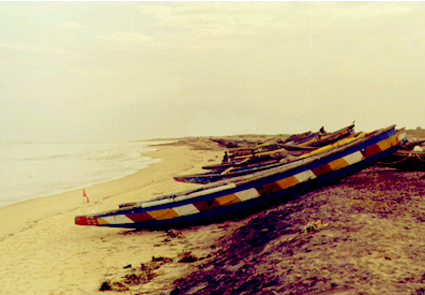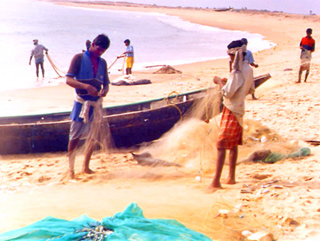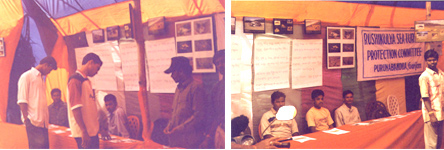 | ||||||||||||||||||
|  Click here to read the latest news from India The olive ridley sea turtle nests at several sites in the western Indian Ocean, Indian subcontinent and Southeast Asia. The single most important breeding area for olive ridleys in the Indian Ocean along the Bay of Bengal is Orissa. In 1993, biologists from the Orissa Forest Department and the Wildlife Institute of India learned that large scale nesting of olive ridley turtles was taking place near the mouth of the Rushikulya river. This area is the location of one of the largest mass nesting (arribada) sites of olive ridley sea turtles in India.  Protection Committee in this Interpretation Center There are several fishing villages near this important nesting site. Local fishers use various fishing methods including gill and drift nets. The villagers have known about the arribadas of olive ridley turtles since time immemorial. 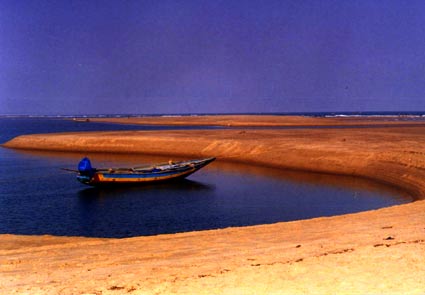 breeding areas for the Olive Ridley sea turtle in the Indian Ocean Hindu mythology worships sea turtles as an incarnation of one the their gods. Thus, most fishing communities along the coast, do not consume turtle eggs or meat. Olive ridley sea turtles nest at this beach without any apparent threats from these local communities. In 1995, the Wildlife Institute of India initiated a research program on olive ridley turtles along Rushikulya rookery. As part of this program, youths from the local communities help tag turtles and collect data. Community groups also provide protection to olive ridleys during the nesting, and hatching seasons. These groups need training in order to continue a long-term conservation program. The Community Reserve at Rushikulya project is designed to mobilize the local community and streamline their conservation efforts by:
 Funds for this project will help provide training manuals for sea turtle monitoring, census techniques, and hatchery management. Moneys will help support educational programs utilizing slides and films about sea turtles and sea turtle conservation issues in villages and schools. The Community Reserve program will also help train local guides for the eco-tourism trade. Community Reserve or Protected Area?
Recently, the World Turtle Trust received a quarterly report from Mr. Basudev Tripathy the leader of the Rushikulya Project in Orissa, India. The torn and tattered parcel arrived at our Honolulu office smelling of sweet Indian incense. In addition to a detailed quarterly report, Mr. Tripathy shared with us the wide variety of training materials that he has incorporated into a vibrant community project.
The package also contained photographs of olive ridley arribadas, fishers with their boats and nets, and a white-washed building that serves as the on-site interpretive training facility. Using extremely modest funds, Mr. Tripathy printed educational pamphlets, procured posters, purchased educational movies, and developed slide shows. His efforts also provided a wide range of educational initiatives for the local populace in five coastal villages.
Tripathy’s goal for this program is to promote the long term survival of the sea turtle population while simultaneously, protecting the welfare and needs of the nearby rural communities that depend on the coastal resources. After setting up a base camp in Purunabandha, Mr. Tripathy trained local community leaders to assist his efforts. Together they conducted interviews with at least 50 individuals in each of five villages. Fisherfolk, coastal dwellers and secondary school students all had an opportunity to speak about their knowledge of sea turtles. They reported their observations of nesting behavior, changes in population trends, and their opinions on how best to protect sea turtles. Mr. Tripathy and his local helpers conducted a survey through the use of questionnaires printed in the regional language of Telugu. He called upon a local bank and an environmental education agency to contribute study materials, posters and pamphlets for an extensive sea turtle awareness campaign. These campaigns extend to the tourists who visit the Rushikulya rookery during the nesting season.
educational exhibitions for villagers Goals for the next quarter include building workshops, publicity campaigns for Community Reserve, training of local villagers to help manage eco-tourists on the beach and in the sea. World Turtle Trust looks forward to the next quarterly report with enthusiasm.
| |||||||||||||||||
| ||||||||||||||||||



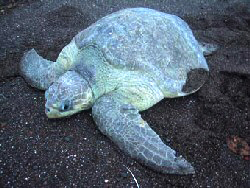 The government of Orissa is planning to declare Rushikulya rookery a Protected Area. Declaration of a Protected Area automatically strips the rights of local people on this traditional sea turtle nesting site. The Indian Wild Life Protection Act (1972), Amendment 2002, has a provision of declaring certain wildlife areas as Community Reserve (CR). The Rushikulya rookery of Orissa coast offers an ideal site for such a Community Reserve. The proposed program will adequately document these efforts and a case will be put up before the State and Union Government to declare Rushikulya rookery as a Community Reserve.
The government of Orissa is planning to declare Rushikulya rookery a Protected Area. Declaration of a Protected Area automatically strips the rights of local people on this traditional sea turtle nesting site. The Indian Wild Life Protection Act (1972), Amendment 2002, has a provision of declaring certain wildlife areas as Community Reserve (CR). The Rushikulya rookery of Orissa coast offers an ideal site for such a Community Reserve. The proposed program will adequately document these efforts and a case will be put up before the State and Union Government to declare Rushikulya rookery as a Community Reserve. 